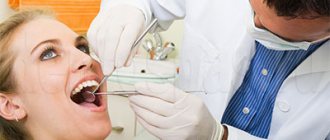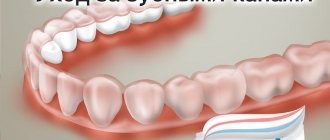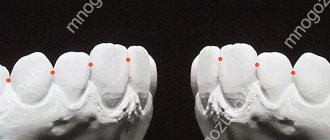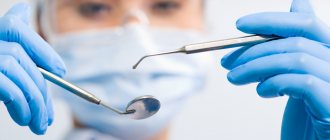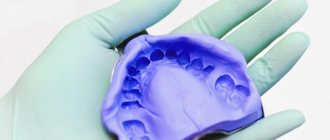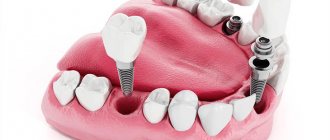Timely prevention of dental diseases can save you from many problems that arise due to improper oral care. There are a large number of different factors that affect the condition of dental tissues. Among them are improper brushing of teeth, poor diet, poor environment, stress, decreased immunity, etc. Regular preventive visits to a good dentist will help you notice the onset of caries and other common diseases in time.
Inspection process
If the patient comes to the clinic without any complaints about his health, the doctor conducts an examination according to the classic scenario. First of all, a visual assessment is necessary: hard and soft tissues, existing crowns and implants, mucous membranes, palate, etc. are carefully examined. This allows you to detect excessive accumulation of plaque, tartar and other deposits. If a stone appears, this may indicate that a person does not pay enough attention and time to oral hygiene.
Professional cleaning using an effective method such as Air Flow may be required to remove stone and hard deposits. The doctor must also examine the enamel, determine the presence of changes in its color, density, and identify the presence of chips and cracks on the surface. When tissue demineralization occurs, strengthening therapy using fluoride-containing drugs may be prescribed.
After this, you can move on to studying the gums: you should check the tissues for the presence of compactions, foci of inflammation, ulcers, etc. The appearance of the tongue, palate, and cheeks is also important. If there are signs of mechanical damage or injury, the doctor may recommend changing your toothbrush and other hygiene devices to more gentle ones.
Where can you find qualified dental specialists in Ivanteevka?
You can get professional dental care and undergo a preventive examination of the oral cavity at Sanident Dentistry, which provides a full range of services in Shchelkovo and in the urban district of Ivanteevka. We offer affordable prices and high-quality dental treatment. We have the most modern diagnostic equipment, proven painkillers, modern filling materials and instruments.
In our clinic you can undergo such hygiene procedures as: fluoridation, removal of dental plaque, AIR FLOW teeth cleaning, teeth whitening using professional preparations, complete professional oral hygiene and much more.
Entrust your health to professionals, do not allow the disease to enter the active stage of development, prevent the disease in a timely manner. Our experienced professionals are ready to help you with this.
The comprehensive dental clinic "Sanident" is located at the following addresses:
- Ivanteevka, st. Novoselki, 4 (Ivanteevka railway station);
- Shchelkovo, st. Central, 80 (railway station Voronok).
Probing
This research method can be carried out to evaluate the reliability and density of the enamel of real teeth and artificial crowns. To do this, the dentist uses an instrument called a probe. With its help, it is possible to determine the presence of carious cavities and the stage of tissue damage. The method is also actively used for the diagnosis of other non-carious diseases, for example, hypoplasia, erosion, fluorosis, etc.
Probing is an absolutely painless and safe process. To check your teeth, the doctor simply needs to run the blunt end of his instrument over the surface of the enamel. This allows you to find irregularities and defects, determine density and hardness. This device can also be used to detect the presence of gum pockets.
Additionally, the dentist can check for gaps between the gum and the crown (or between healthy areas of enamel and the filling material). If there is a severe gap, the filling will need to be reinstalled.
Top most frequently asked questions to pediatric dentists and orthodontists
At what age should a child be shown to the dentist for the first time?
If a baby develops strong, white teeth one after another, starting from 6-8 months, then the child should be brought to the pediatric dentist at 2 years of age.
To be examined by an orthodontist at 4-5 years of age.
Why treat baby teeth?
Any tooth affected by caries is a source of chronic infection, which has a negative effect on the entire body. This chronic source of infection must be removed as soon as possible. How? The best way, if you think about the future, is to cure the tooth. The fastest way is to remove the causative tooth. If you treat a baby tooth, it will save space for the future permanent tooth and continue to take part in chewing. If a tooth is removed, there will be very little or no space left for a permanent tooth. When changing teeth, the permanent tooth will erupt as a “second row”, causing malocclusion.
If a doctor removes a baby tooth, won’t the permanent one immediately erupt in its place?
The permanent tooth will erupt when its time comes. Nature has set a strictly defined time for each tooth to appear in the oral cavity. Removing the milk precursor can speed up the process quite a bit.
Why are children's temporary prophylactic dentures made before the eruption of a permanent tooth?
If a baby tooth still had to be removed because it was too late to treat it, then you should definitely consult with an orthodontist. Nature does not tolerate emptiness and very quickly this emptiness, which formed after tooth extraction, turns into a gap due to the movement of neighboring teeth and there is simply no room left for the future permanent tooth in the dentition.
If after the removal of a baby tooth there is 1 year or more left before the permanent tooth erupts, then a plastic tooth is made that will save space for the permanent tooth. This is a children's prosthetic prosthesis.
Are there really teeth that come out immediately permanent, without milk predecessors?
Yes, everyone knows the sixth, seventh and eighth (“wisdom”) teeth, if you count from the first central tooth in each direction. Immediately permanent, without milk precursors, the following appear: the 6th tooth (at 5-6 years), the 7th (at 11-12 years), and the wisdom tooth after 16 years.
At what age is it most effective to install braces?
The ideal age for installing braces is 9-11 years old. At this age, due to the growth of the jaw, the absence of the 7th teeth and the opportunity to teach the child to take good care of the braces system, the orthodontist has a good chance of completing the treatment “without tooth extraction,” straightening the teeth and even completely correcting the bite. Also, treatment at this age has the most favorable prognosis regarding the stability of the result obtained.
What to do if a child has “weak” enamel and uneven teeth?
If the situation is critical, the bite is severely disturbed, or the child does not smile due to crooked teeth, and the enamel is significantly weakened, we suggest installing a brace system on the tongue side. But not a classic lingual brace system, which will constantly come off for a child and impair diction, but an INCOGNITO brace system with wide bases, individually manufactured for each of your child’s teeth in a laboratory in Germany.
Fissure sealing – what is actually being sealed?
Many parents have a negative attitude towards this procedure, believing that caries occurs under the sealant (special varnish). Given the technology, this is not the case. After cleaning the tooth with a special paste using ultrasound, the doctor applies a thin layer of fluoride varnish, which smoothes out the deep anatomical pits and grooves (fissures) on the tooth. If sealing is not done, then over time an invisible white coating accumulates in the fissures, containing microorganisms that, in the course of their vital activity, release acids and the tooth enamel begins to gradually dissolve, caries appears in the “white spot” stage, which is not visible to the eye. And when the coloring of this caries with pigments appears and it becomes noticeable, the caries already affects the entire thickness of the enamel. The sooner you contact a pediatric dentist, the greater the chance that there is no caries in the fissure in the form of a “white spot.” The doctor can easily check this by staining the chewing surface of the tooth with a caries marker before sealing.
What does it mean if all your teeth have been replaced, but one or two baby teeth still won’t fall out?
This means that the permanent tooth is “stuck” somewhere in the bone tissue and needs to be pulled into place. There may be another situation - the germ of a permanent tooth has not formed. In both cases, you should definitely consult an orthodontist.
If an X-ray of a 12-year-old child does not show the germ of a permanent tooth, can it appear later?
No, he can not. If the tooth germ is absent on the x-ray, and therefore in the bone tissue, it will never appear again and this permanent tooth will be absent from the oral cavity. The exception is wisdom teeth.
When and where to “cut” the frenulum, in the maternity hospital or in dentistry?
In the maternity hospital, the frenulum of the tongue is cut when the child cannot perform sucking movements due to the low mobility of the tongue, which is restrained by this very frenulum.
The frenulums of the upper and lower lips, in the case of a gap between the central teeth (diastema), are trimmed (in these cases, it would be more correct to say frenuloplasty) not earlier than the permanent incisors, second from the center, begin to erupt. Such plastic surgery can be performed correctly by a doctor who knows a special technique, which subsequently helps to close the diastema. Plastic surgery of the frenulum of the upper and lower lips is done only in the direction and under the supervision of an orthodontist, otherwise the diastema may persist.
What does it mean if a child has snow-white spots and stripes on his permanent teeth that were not there before?
This means that the child is not cleaning the surface of the tooth enamel properly. This may be a lack of knowledge of teeth brushing techniques or a toothbrush that is too soft. Or – lack of regular teeth brushing as such. A thin, dense layer of plaque that has accumulated over weeks and months on the surface of the tooth dissolves the enamel and it begins to turn white (demineralize).
Why wear trainers and plates when you can get braces right away?
Trainers, like plates, are effective at a certain age as the child grows. It is at this age that jaw growth can be directed in the desired direction, and the braces system can be installed early. Braces are installed at a later age to completely straighten the teeth.
Why do children need to be treated by a special dentist – a pediatric dentist?
Milk teeth are very different from permanent teeth, but their main feature is the location of the “nerve” close to the surface of the tooth, absorbable roots and the proximity of the permanent tooth germ. Children's permanent teeth also have a number of features, the most important of which are immature enamel and developing (growing) roots. Only a dentist with special education knows how to treat children’s teeth.
What to do if the baby tooth has not yet fallen out, but the permanent one is trying to erupt nearby?
It is necessary to contact a pediatric dentist as soon as possible to remove a baby tooth to make room for a permanent tooth. If a baby tooth is removed on time, there is a chance that the permanent tooth will erupt smoothly.
Is it normal that at the age of 5 – 7 years a child develops gaps between his milk teeth, which were previously tightly spaced?
This is how nature intended. Before changing teeth, the child’s jaws begin to grow, the size of the baby teeth does not change, and this contributes to the appearance of gaps that will be needed to accommodate future permanent teeth.
If gaps do not appear at this age, it means something has gone wrong and you should consult an orthodontist.
Anna Redko, chief physician of the Russian-German network of dentists “Clinic of Doctor Lange”.
Palpation and percussion
This technique is used to assess the health of periodontal tissues. To do this, the specialist carefully moves the tooth to the right and left using medical tweezers, checking its mobility and ability to move. If the coronal part moves easily, this indicates the presence of serious inflammation or indicates tissue swelling.
Such consequences can occur due to severe injuries to the jaw, as well as diseases such as periodontitis, periodontitis or periodontal disease. Using palpation, the doctor assesses the degree of pain of the procedure for the patient, because pain can be of varying intensity depending on the complexity of the pathology and its location.
Percussion is a method in which the doctor gently taps the surface of the tooth crowns with a probe or other device. If unpleasant sensations occur with horizontal impacts, this indicates the development of periodontitis; if with vertical impacts, then this indicates an inflammatory process in the pulp chamber. Based on the data obtained, the specialist can make a preliminary diagnosis and send the patient for further examination. Sometimes, during the general examination, an x-ray is prescribed; this is necessary to confirm the diagnosis.
Dentist consultation
It is carried out in two stages. Before the examination begins, the doctor talks with the patient, interviews him, collects information about existing complaints, previous treatment, the presence of concomitant or systemic diseases, possible contraindications for certain treatment methods. The goal is to collect general information about your health status.
The second stage of consultation is carried out after the examination. The dentist talks about identified dental problems, offers treatment options, and schedules the next appointment. If the appointment was preventive and the patient is healthy, the doctor can give recommendations on dental care and set a date for the next examination (usually every six months or more often if there are indications for this).
When should you undergo a general examination by a dentist?
Experienced dentists and orthodontists strongly recommend visiting a dental clinic for a preventive examination at least once every 6 months. This should be done even if there are no complaints. If you have any unpleasant sensations, you should not delay your visit to a medical facility for even a minute.
There are several main causes for concern: increased sensitivity of the enamel, pain in the gums under the denture, swelling, redness and any other visible tissue changes. Also, one of the symptoms of developing pathology is a strong smell from the mouth, which does not disappear even after brushing.
Abundant accumulation of plaque and tartar, changes in the shade and transparency of the enamel, bleeding - all this is a good reason to visit your doctor. Also, consultation and examination are required before orthodontic treatment.
previous post
Why are my teeth numb?
next entry
When to take a child to the dentist - schedule of visits to the dentist for children of different ages
The birth of a child takes place in the presence of doctors. In the future, especially in the first years of the baby’s life, he and his parents will have to regularly visit various doctors, including the dentist. Unfortunately, parents pay undeservedly little attention to the health of their child’s teeth, and in the vast majority of cases, the first visit to the doctor is associated with acute pain, complications of caries, and less often - the manifestation of inflammatory diseases of the soft tissues of the oral cavity.
When to visit the dentist, what and at what age you need to pay attention.
How much does it cost to see a doctor?
Many clinics now offer a free consultation before dental implantation. And not only before implantation, but also before installing a prosthesis or treating caries. And some dentists also provide free diagnostics - absolutely everything (tests, CT scans, taking impressions, etc.). Of course, this is a pleasant bonus for the patient, because implantation is an expensive treatment. However, be careful, in any self-respecting clinic, even before implantation, but after consultation, an agreement is drawn up. It specifies all the materials (implants, medications), work on installing implants and prostheses - prices are completely transparent and without pitfalls or hidden items.
[1] Lebedenko I.Yu., Arutyunov S.D., Ryakhovsky A.N. Prosthetic dentistry: national guidelines, 2022.
Author: Izhmukov V.V. (Thank you for your help in writing the article and the information provided)
For little ones (3-5 years):
Games, cartoons.
On the Internet you can find many games in which your child will act as a dentist and cure the teeth of the main character. Links to games for: Android, iOS
We also recommend that you pay attention to cartoons about teeth and dentists:
- - “Tari Bird”, “Brushing Teeth with Hello Kitty”, “Krosh’s New Teeth”, “Good Doctor Dentist”, “Rabbit Dentist” and others. We have made a special selection for you of the best cartoons. You will find it in this article.
Feel free to add the fairy tale about Aibolit to your arsenal too.
Scene at home.
At home, you can act out a scene in which you can assign the roles of a little patient, a doctor, and a parent. Then change. During the game, explain to the child in detail what the dentist does, talk about the mirror in which teeth are visible from all sides, about water from a small hose, about the bottles of vitamins that are on the doctor’s table.
It is better to play such scenes many times, using dolls and soft toys as patients.
While brushing your teeth.
You can gradually prepare your child for the visit while brushing his teeth. During the cleaning process, explain to the child about the microbes that live on the tooth and can ruin it, about the doctor who knows how to save the tooth and drive away the germs. Thus, when the time comes to visit the dentist, this need will not be unexpected for the child and parents will spend much less time on final preparation.
The first visit is just an inspection.
If you see that the child is very afraid, then it is recommended not to take risks on the first visit. Let the doctor just look, take a photo of the tooth, pour some water, and silver plate it. The main thing is to form the opinion that visiting the dentist is a common thing, albeit not the most pleasant one.
Consolidation of the result is encouragement.
Before the appointment, be sure to promise your child that his wishes will come true - to go to the attractions, go to the garage with dad, go to bed an hour later, set aside extra time for watching cartoons (if you usually limit it), buy a coveted toy, and so on. Feel free to add stories about gifts from the tooth fairy to your arsenal.
It is important to follow two rules here: first - one visit, one wish (or gift), and second - be sure to fulfill what you promised, even if it was just an inspection.
Next time, promise your child that your wish will come true if he behaves at the appointment as you agreed (listen to the doctor, don’t be capricious, be patient for a while if it hurts).
